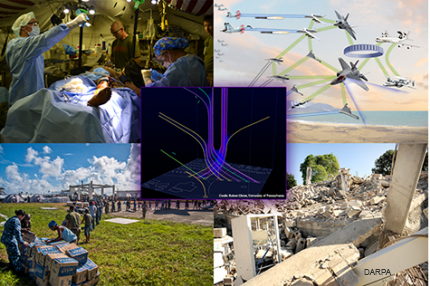DARPA looks to build a foundation for systems-of-systems
The CASCADE program aims develop new mathematical that would enable complex, dynamic systems that aren’t currently possible.

The Pentagon has been focusing recently on developing system-of-systems approaches as a way to integrate multiple platforms and information feeds (say, linking manned and unmanned aircraft, or air and ground vehicles, or various infrastructure components) on open architectures and, ultimately, optimize operations.
Research and development efforts to date have involved everything from operations in the air, on the seas, on the ground, and even testing network hardware.
The problem, according to the Defense Advanced Research Projects Agency, is that such concepts are easier said than done with the technology currently available. So DARPA has launched an overarching program called CASCADE—for Complex Adaptive System Composition and Design Environment—to address the challenges of system-of-systems development. The agency has set a Proposer’s Day for CASCADE to be held Dec. 9 in Arlington, Va.
DARPA says in a Special Notice announcing the event, “it is difficult to model and currently impossible to systematically design such complex systems using state of the art tools, leading to inferior performance, unexpected problems, and weak resilience.” The program intends to research ways to use applied mathematics, modeling and other techniques to find new ways to develop complex, dynamics systems.
“CASCADE aims to fundamentally change how we design systems for real-time resilient response within dynamic, unexpected environments,” John Paschkewitz, DARPA program manager, said in an announcement. “Existing modeling and design tools invoke static ‘playbook’ concepts that don’t adequately represent the complexity of, say, an airborne system of systems with its constantly changing variables, such as enemy jamming, bad weather, or loss of one or more aircraft.”
In addition to warfighting systems, CASCADE’s research could help improve activities such as forward--deployed medical care, by ensuring that the components involving “surgeons, helicopters, communication networks, transportation, time, and blood supply—are accurately modeled and understood,” Paschkewitz said.
A new model for development could also improve humanitarian response to disasters. “We need new design and representation tools to ensure resilience of buildings, electricity, drinking water supply, healthcare, roads and sanitation when disaster strikes,” he said. “CASCADE could help develop models that would provide civil authorities, first responders and assisting military commanders with the sequence and timing of critical actions they need to take for saving lives and restoring critical infrastructure. In the stress following a major disaster, models that could do that would be invaluable.”
At its Proposer’s Day, DARPA wants to attract representatives of government, academic and industry organizations—including non-traditional vendors and potential first-time government contractors—interested in teaming arrangements that could combine expertise in pursuing CASCADE’s goals. Through the program, the agency wants to develop a unified view of system behavior that enables understanding of how complex systems interact, provides a way to make use of that understanding, and dynamically identify and fix deficiencies in the system. A part of making that work, the notice says, would be a formal language that supports the design of such adaptive systems.
Interested parties can attend in person or via webcast. Registration for the event closes Dec. 2.